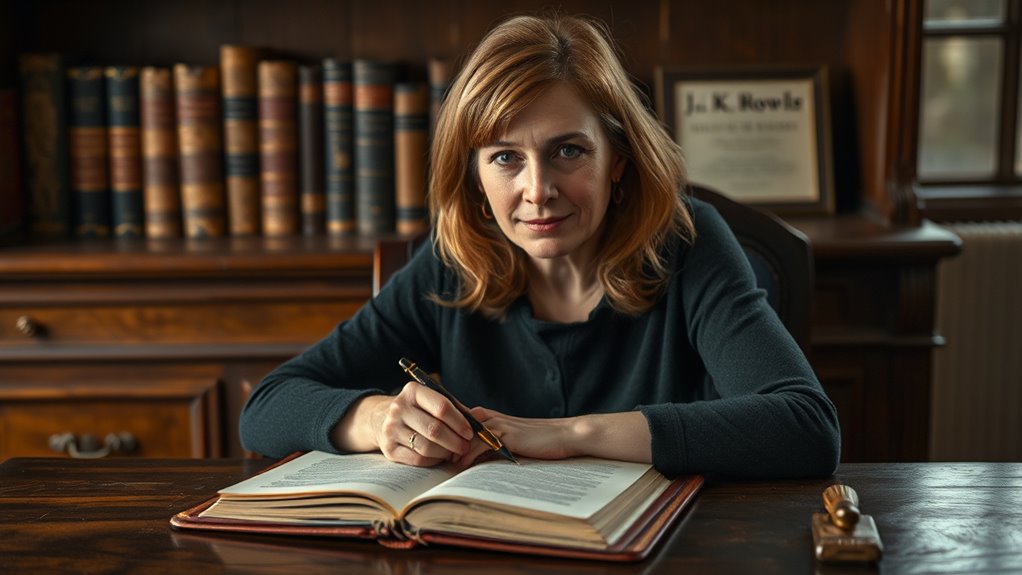J.K. Rowling is the British author behind the beloved Harry Potter series, which has sold over 600 million copies globally and expanded into movies, games, and spin-offs. Her journey from childhood dreams, facing personal struggles, to finally realizing her literary success shows her resilience. Rowling’s influence extends beyond Harry Potter through her other works and pseudonyms like Robert Galbraith. If you’re curious about her inspiring story and the magic behind her creations, there’s more to uncover.
Key Takeaways
- J.K. Rowling is the British author who created the globally bestselling Harry Potter series, beginning with “Harry Potter and the Philosopher’s Stone” in 1997.
- Her personal background includes overcoming early life challenges and financial struggles before achieving literary success.
- Rowling developed a detailed magical universe with unique characters, settings, and lore that underpin the Harry Potter books.
- Besides Harry Potter, she writes under pen names like Robert Galbraith, producing crime fiction and other literary works.
- The Harry Potter series has sold over 600 million copies worldwide and expanded into films, merchandise, and a TV series.
Early Life and Education

J.K. You were born on July 31, 1965, at Yate General Hospital near Bristol, England. Growing up, you spent most of your childhood in Gloucestershire and Chepstow, Wales. Your father, Peter, worked as an aircraft engineer at Rolls Royce Bristol, while your mother, Anne, was a science technician in the chemistry department. You have a younger sister named Di. From a young age, you loved reading and writing; at six, you wrote your first story about a rabbit, and by eleven, you authored a novel about cursed diamonds. Attending Wyedean School and College from age eleven, you faced bullying but found inspiration in teachers emphasizing writing skills. Your early years were shaped by a love of literature and a challenging family situation, including your mother’s diagnosis of multiple sclerosis. Her mother’s illness profoundly influenced your understanding of adversity and compassion, themes that later appeared in your writing.
The Birth of Harry Potter

You might be surprised to learn that Harry Potter’s story began during a delayed train ride from Manchester to London in 1990, when J.K. Rowling suddenly visualized the character and his world. This moment sparked her childhood dreams of magic, transforming into a fully developed idea in just four hours. From that train journey, she started shaping the magical universe that would captivate millions. However, it’s important to recognize that the environmental and health impacts of burning wood for fuel are significant, contributing to air pollution and climate change.
Inspired by Childhood Dreams
The birth of Harry Potter was deeply rooted in Rowling’s childhood dreams and personal experiences. You might notice how Harry’s mischievous, adventurous spirit mirrors Ian Potter, a childhood friend known for playing pranks near Bristol. Rowling drew from her neighborhood interactions, using her memories to make Harry’s character feel real. Her childhood home in Tutshill, Gloucestershire, and the nearby Forest of Dean inspired settings like the cupboard under the stairs and Harry’s humble beginnings. Traits like Hermione’s intelligence and Ron’s loyalty reflect Rowling’s own youth and friendships, bringing authenticity to her characters. She also incorporated British folklore, mythology, and classical stories she loved as a child, blending fantasy with everyday life to create a world that feels both magical and familiar. Her childhood experiences and love for storytelling helped shape the rich, relatable universe of Harry Potter. Additionally, her understanding of sound healing science and the importance of sound vibrations may have subtly influenced her use of magical spells and incantations, adding an extra layer of depth to her world-building.
The Train Journey Idea
Have you ever wondered where the idea for Harry Potter first took shape? It all started on a train from Manchester to London in 1990. The train was delayed, giving you extra time to let your mind wander. Without any writing tools, your thoughts raced, and suddenly, the image of a boy wizard attending a magical school appeared instantly. This moment of pure inspiration struck during that long journey, sparking the entire series. You didn’t need paper or pen—just your imagination. Over the next five years, you developed the idea into a full story, shaping what would become the Harry Potter series. That delayed train ride became the birthplace of a worldwide phenomenon, forever changing literature and popular culture. Inspired during a train journey from Manchester to London in 1990. Recognizing the importance of creative inspiration can sometimes be the catalyst for groundbreaking ideas.
Developing the Magical World
The spark that ignited Harry Potter’s magical world stemmed from careful and detailed planning by J.K. Rowling. She drew inspiration from real-world fears and historical events, shaping a secretive, immersive universe centered around Hogwarts. Instead of creating an entire world at once, she focused on rich details in key areas like magical creatures, spells, and social structures, ensuring depth over breadth. She designed a complex society with hierarchical houses, family allegiances, and a history woven into the narrative. Rowling’s magical system follows specific rules, with laws governing wand use, spells, and artifacts like the Resurrection Stone. Her meticulous notes, long-term development, and personal influences helped craft a believable, authentic universe that feels both fantastical and rooted in reality. Additionally, her emphasis on consistent color and contrast within her storytelling helped create vivid, immersive scenes that enhance the reader’s experience.
Overcoming Challenges in Writing

You face many hurdles when turning ideas into a finished story, and Rowling’s journey proves perseverance is key. She rewrote parts of her books countless times and pushed through setbacks like financial struggles and personal losses. Her resilience shows that overcoming obstacles is essential to creating something truly memorable. Additionally, adopting effective exfoliation techniques can help maintain healthy skin, similar to how persistence in writing leads to success.
Financial Hardships and Persistence
How did J.K. Rowling push through her financial hardships? After returning to the UK post-divorce, you’d find her living on welfare benefits, raising a child, and writing on a typewriter in cafes. Despite emotional lows and feelings of failure, she kept working on her Harry Potter manuscript, balancing motherhood, studies, and poverty. Facing about twelve publisher rejections, she refused to give up—each no brought her closer to success. Persistence paid off when a lesser-known agent finally offered a deal for 500 copies with a modest advance. Her struggles with depression and personal loss fueled her creativity, turning pain into powerful storytelling. Her cultural background and resilience also played a role in shaping her determination. Over years, her dedication transformed her from welfare-dependent single mother into a billionaire author, proving that perseverance can turn adversity into extraordinary achievement.
Personal Losses and Resilience
J.K. Rowling faced immense personal losses that tested her resilience. When her mother died on New Year’s Day, 1991, she was only 25, right as she was beginning to write Harry Potter. Her grief deeply influenced the series, especially Harry’s orphanhood and themes of death. Around the same time, her marriage in Portugal ended after domestic abuse, forcing her to return to the UK as a single mother. Living in poverty, she relied on welfare, writing in cafés with her daughter sleeping nearby. During this dark period, Rowling battled severe depression but used writing as a refuge. Her perseverance helped her transform personal tragedy into powerful stories of hope and courage, inspiring readers worldwide and illustrating her incredible resilience through adversity. Her story of overcoming hardship has become a symbol of hope for many facing their own struggles. Additionally, her experience highlights how emotional support and energetic alignment can play a vital role in overcoming life’s challenges.
The Success of the Harry Potter Series

What makes the Harry Potter series stand out as one of the most successful literary phenomena in history is its extraordinary global reach and record-breaking sales. You can’t ignore that over 600 million copies have been sold worldwide, making it the best-selling series ever. It’s been translated into more than 80 languages, from Hawaiian to Hebrew, reaching diverse audiences. In the U.S. alone, 230 million copies have been sold, with one in fifteen people owning a Harry Potter book.
Here are three key highlights:
- *Harry Potter and the Deathly Hallows* sold 11 million copies in 24 hours.
- The final book sold 8.3 million copies on its release day in the U.S.
- The series has generated approximately $7.7 billion in revenue, cementing its cultural and financial legacy.
Expanding the Wizarding World

Building on the success of the original Harry Potter series, the Wizarding World continues to expand through various multimedia and publishing initiatives. In August 2025, Bloomsbury will launch the Pocket Potters Illustrated Companion Series, targeting 7–10-year-olds with vibrant, easy-to-read guides about Harry, Ron, and Hermione. These small-format books feature humorous insights, fun facts, and colorful illustrations about spells, magical creatures, and Hogwarts quirks, appealing to both young and older fans. Meanwhile, the franchise broadens on screen with a new Harry Potter TV series in development for HBO, each season adapting a main book. Additionally, *Hogwarts Legacy*, a major video game released in 2023, immerses players in the Wizarding World’s magic and adventure, further engaging fans worldwide. The ongoing expansion also highlights the importance of magical education in engaging new generations of fans and keeping the stories alive.
Writing Beyond Harry Potter

Have you ever wondered how an author can successfully shift from beloved fantasy series to explore entirely different genres? J.K. Rowling has done just that, venturing into adult fiction, crime series, and non-fiction. Here are three ways she’s expanded her writing beyond Harry Potter:
- She published *The Casual Vacancy* in 2012, tackling dark social issues like drugs and politics, with a structure mirroring Harry Potter’s seven-part division.
- Under the pseudonym Robert Galbraith, she created the Cormoran Strike detective series, renowned for complex characters and intricate plots.
- Rowling also writes non-fiction, like *Very Good Lives*, offering life lessons, and children’s books such as *The Ickabog* and *The Christmas Pig*.
- Her exploration of literary versatility demonstrates her desire to explore diverse themes and audiences beyond her original fantasy works.
Significance of Pen Names and Pseudonyms

Pen names and pseudonyms serve as powerful tools for authors to shape their literary identities and influence how their work is perceived. For you, choosing a pseudonym like J.K. Rowling helped obscure gender biases, making your fantasy books more accessible to boys who might shy away from female authors. Using initials “J.K.” also created a neutral, easy-to-pronounce name that appealed broadly. When you adopted Robert Galbraith, it allowed you to explore crime fiction without the weight of your Harry Potter fame, targeting a genre-specific audience. Pseudonyms give you the freedom to experiment, avoid preconceived notions, and manage branding. Revealing your true identity as Galbraith surprised many, showcasing how gender and genre perceptions shape marketing strategies and reader expectations. Her real name, Joanne Rowling, is rarely used in her professional career, emphasizing the importance of a pseudonym in her success.
Rowling’s Impact and Legacy

What makes J.K. Rowling’s impact and legacy truly remarkable is how she transformed the literary and cultural landscape. You should know that her Harry Potter franchise created a £9.3 billion industry, inspiring a global fandom and a thriving merchandise ecosystem.
Here are three key ways her influence persists:
- It revitalized book publishing, especially in young adult fiction, encouraging new authors and genres.
- Rowling mainstreamed fantasy, pushing it into the mainstream and elevating storytelling standards with complex characters and moral dilemmas.
- Her work has motivated educators worldwide to incorporate Harry Potter into curricula, promoting literacy and ethical discussions.
- Additionally, her success has highlighted the importance of market influence, inspiring other authors and entrepreneurs to leverage intellectual property for broader cultural and commercial impact.
Her legacy extends beyond literature, shaping industries, inspiring social conversations, and leaving a lasting mark on global culture.
Frequently Asked Questions
What Inspired J.K. Rowling to Create the Harry Potter Universe?
You’re curious about what sparked the creation of the Harry Potter universe. You might find that her childhood friendships, especially with someone like Ian Potter, inspired some characters. Her personal experiences, like writing in Edinburgh and being a single mom, influenced themes of perseverance. An idea struck her during a train delay, and her love of folklore, mythology, and historical stories helped shape the magical world you enjoy today.
How Does Rowling Develop Her Characters and Storylines?
You might think developing characters and storylines is just about inventing plots, but it’s deeper. You actively craft multidimensional characters with unique traits, flaws, and emotional arcs. You integrate their backstories and motivations into the story, making each one feel real and relatable. By layering themes, conflicts, and relationships, you create engaging narratives that evoke strong emotions, allowing readers to connect deeply with your characters and their journeys.
You learn that her favorite books include classics like Jane Austen’s “Emma,” which she’s read over 20 times, and Dickens’s “A Tale of Two Cities.” She also loves children’s literature like E. Nesbit’s “The Story of the Treasure Seekers” and Roald Dahl’s “Matilda.” Political and modern works such as “Team of Rivals” and “Animal Farm” inspire her, alongside favorites like “The Song of Achilles” and Wodehouse’s witty stories.
How Does She Balance Her Writing Career With Philanthropy?
Balancing your writing career with philanthropy is like juggling glowing orbs—you aim to keep all in motion without dropping any. You integrate charity into your life, using your fame to raise awareness and delegate tasks through trusts. Public appearances support causes without draining your creative energy. Your stories inspire societal change, so you use your voice wisely, ensuring your work and giving continue to shine brightly, each fueling the other seamlessly.
What Advice Does Rowling Give to Aspiring Writers?
When you ask about advice for aspiring writers, it’s important to remember that perseverance and authenticity matter most. Keep writing regularly, even if it’s hard, and don’t be afraid to make mistakes or face rejection. Stay true to your voice, read widely, and analyze what makes your favorite books work. Believe in your story’s value, be patient, and keep pushing forward—success often comes after persistence and genuine passion.
Conclusion
As you navigate Rowling’s journey, you see a phoenix rising from ashes, transforming setbacks into soaring triumphs. Her words weave a magical tapestry that enchants millions, leaving an indelible mark on literary history. Like a wand in a skilled hand, her storytelling sparks imagination and hope. Rowling’s legacy, a luminous star in the night sky, reminds you that perseverance can turn the darkest moments into shimmering constellations of success.










